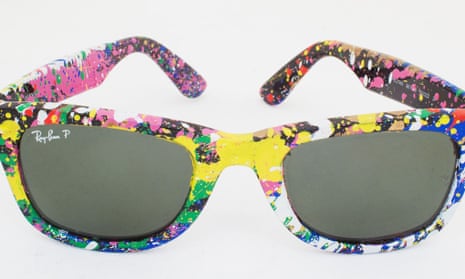If, like no one, you have been wondering what happened to Mr Brainwash, the bizarre “accidental” protagonist of Exit through the Gift Shop, wonder no more because he has moved into the world of accessories. The pseudo-artist has just collaborated with Sunglasses Hut to design a 250-piece line of parody-free, paint-splattered Raybans for their New York SoHo shop.
Were you to pick one graffiti artist to work with, Brainwash is hardly surprising – Mr Brainwash (real name, Thierry Guetta) became the poster boy for the commercialisation of art after landing a bizarre gig as Banksy’s guide, the story of which became the 2010 film. But in truth, fashion has a longstanding relationship with street art.
From the Moschino AW15 show – think floor-length gowns scrawled with Moschino’s own tags, as seen on Katy Perry and Madonna at the Met Ball last week – to one of fashion’s most famous collaborations, between Louis Vuitton and the late Stephen Sprouse in the early noughties, graffiti and fashion have had a long and happy marriage. Sprouse’s bright, brush-stroked graffiti-style words tagged onto LV pieces were a sort of flip on the controlled monogram usually associated with Louis Vuitton – and the six-year collaboration proved to be one of the brand’s most lucrative moves.

The Guardian’s art critic Jonathan Jones thinks the two marry perfectly: “In fact, the beginnings of modern street art lie in a fusion of art, youth culture, pop and fashion in 1980s New York. Artists such as Keith Haring and Jean Michel Basquiat moved very easily between ‘outsider’ and ‘insider’ culture. This movement was influenced by punk fashions in the 1970s where people wrote on their clothes etc”. Haring, of course, collaborated with Vivienne Westwood in the 1980s on her “witches” collection, turning his pop graffiti drawings onto Westwood’s boxy pieces. In 2011, British designers Agi & Sam showed an autumn/winter collection which borrowed from the Jean Michel Basquiat’s graphic prints.
So what’s the appeal? “Graffiti has become an art form admired by the middle classes. Modern street art is not spontaneous but very stylised, very self conscious, and this means it is totally natural for street artists to move from the car park to the catwalk,” explains Jones. What once was seen purely as vandalism or a form of protest has evolved into something for the middle-market. It’s in art galleries. It on slogan tees. Banksy has made a killing out of it. In Athens, for example, developers have been known to pay select street artists to graffiti wall-space in a bid to gentrify the area. Urban graffiti tours are on the mainstream tourist trail.
Set designer Gary Card thinks the connection is purely aesthetic: “It’s colourful, it’s catchy, it’s pop, so it makes sense that those graphic ideas will translate to well to print and accessories.” Card, who created the cartoonish background installation for JW Anderson’s 2013 Topshop collaboration, thinks of all the genres, the appeal lies in its immediacy: “It has to be, by the very nature of how its created.”

But while it might work as a print, there is a flipside. Arguably, this look was responsible for a trend in “trashion”, from the weird trend for celebrities such as Kim Kardashian, Lady Gaga and Rita Ora to deface their Hermès bags a few years ago to Converse which has rolled out a whole campaign – Made By You – based on defaced trainers.
There is also an argument that since this expressive art form was (by and large) born out of less than ideal conditions, is it right to transfer it onto the catwalk? It is often seen as a form of protest, contextualising the political stance of, say, a city’s disenfranchised youth. See everything from the economic conditions in 1970s and 1980s New York, to last week’s election results. As Jones explains: “The idea – I’d go as far as to say myth – that graffiti is a rebel subculture and therefore incompatible with fashion originates with the French artist Jean Dubuffet who coined the term ‘art brut’ meaning ‘raw art’. For Dubuffet the graffiti he saw on 1940s and 50s streets was a form of raw art untamed by society. This rawness, however, has long since been lost”.

Perhaps it’s a case of separating the two, of viewing this art form in a purely visual way, of borrowing its style rather than appropriating its roots. That way, through accepting the constantly changing expressions found in street fashion and graffiti, it can continue to influence trends. Even if one of them happens to be sunglasses.

Comments (…)
Sign in or create your Guardian account to join the discussion